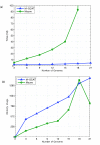M-GCAT: interactively and efficiently constructing large-scale multiple genome comparison frameworks in closely related species
- PMID: 17022809
- PMCID: PMC1629028
- DOI: 10.1186/1471-2105-7-433
M-GCAT: interactively and efficiently constructing large-scale multiple genome comparison frameworks in closely related species
Abstract
Background: Due to recent advances in whole genome shotgun sequencing and assembly technologies, the financial cost of decoding an organism's DNA has been drastically reduced, resulting in a recent explosion of genomic sequencing projects. This increase in related genomic data will allow for in depth studies of evolution in closely related species through multiple whole genome comparisons.
Results: To facilitate such comparisons, we present an interactive multiple genome comparison and alignment tool, M-GCAT, that can efficiently construct multiple genome comparison frameworks in closely related species. M-GCAT is able to compare and identify highly conserved regions in up to 20 closely related bacterial species in minutes on a standard computer, and as many as 90 (containing 75 cloned genomes from a set of 15 published enterobacterial genomes) in an hour. M-GCAT also incorporates a novel comparative genomics data visualization interface allowing the user to globally and locally examine and inspect the conserved regions and gene annotations.
Conclusion: M-GCAT is an interactive comparative genomics tool well suited for quickly generating multiple genome comparisons frameworks and alignments among closely related species. M-GCAT is freely available for download for academic and non-commercial use at: http://alggen.lsi.upc.es/recerca/align/mgcat/intro-mgcat.html.
Figures





Similar articles
-
COMPAM :visualization of combining pairwise alignments for multiple genomes.Bioinformatics. 2006 Jan 15;22(2):242-4. doi: 10.1093/bioinformatics/bti759. Epub 2005 Nov 3. Bioinformatics. 2006. PMID: 16269416
-
PSAT: a web tool to compare genomic neighborhoods of multiple prokaryotic genomes.BMC Bioinformatics. 2008 Mar 26;9:170. doi: 10.1186/1471-2105-9-170. BMC Bioinformatics. 2008. PMID: 18366802 Free PMC article.
-
Efficient multiple genome alignment.Bioinformatics. 2002;18 Suppl 1:S312-20. doi: 10.1093/bioinformatics/18.suppl_1.s312. Bioinformatics. 2002. PMID: 12169561
-
Combo: a whole genome comparative browser.Bioinformatics. 2006 Jul 15;22(14):1782-3. doi: 10.1093/bioinformatics/btl193. Epub 2006 May 18. Bioinformatics. 2006. PMID: 16709588
-
Modern technologies and algorithms for scaffolding assembled genomes.PLoS Comput Biol. 2019 Jun 5;15(6):e1006994. doi: 10.1371/journal.pcbi.1006994. eCollection 2019 Jun. PLoS Comput Biol. 2019. PMID: 31166948 Free PMC article. Review.
Cited by
-
Mumemto: efficient maximal matching across pangenomes.bioRxiv [Preprint]. 2025 Jan 5:2025.01.05.631388. doi: 10.1101/2025.01.05.631388. bioRxiv. 2025. Update in: Genome Biol. 2025 Jun 17;26(1):169. doi: 10.1186/s13059-025-03644-0. PMID: 39803467 Free PMC article. Updated. Preprint.
-
IncH-type plasmid harboring bla CTX-M-15, bla DHA-1, and qnrB4 genes recovered from animal isolates.Antimicrob Agents Chemother. 2014 Jul;58(7):3768-73. doi: 10.1128/AAC.02695-14. Epub 2014 Apr 21. Antimicrob Agents Chemother. 2014. PMID: 24752252 Free PMC article.
-
Genome and transcriptome analysis of surfactin biosynthesis in Bacillus amyloliquefaciens MT45.Sci Rep. 2017 Jan 23;7:40976. doi: 10.1038/srep40976. Sci Rep. 2017. PMID: 28112210 Free PMC article.
-
Evolution of Tandem Repeat Satellite Sequences in Two Closely Related Caenorhabditis Species. Diminution of Satellites in Hermaphrodites.Genes (Basel). 2017 Nov 28;8(12):351. doi: 10.3390/genes8120351. Genes (Basel). 2017. PMID: 29182550 Free PMC article.
-
Comparative phylogenetic analysis of genome-wide Mlo gene family members from Glycine max and Arabidopsis thaliana.Mol Genet Genomics. 2014 Jun;289(3):345-59. doi: 10.1007/s00438-014-0811-y. Epub 2014 Jan 28. Mol Genet Genomics. 2014. PMID: 24469270
References
-
- Margulies M, Egholm M, Altman WE, Attiya S, Bader JS, Bemben LA, Berka J, Braverman MS, Chen YJ, Chen Z, Dewell SB, Du L, Fierro JM, Gomes XV, Godwin BC, He W, Helgesen S, Ho CH, Irzyk GP, Jando SC, Alenquer MLI, Jarvie TP, Jirage KB, Kim JB, Knight JR, Lanza JR, Leamon JH, Lefkowitz SM, Lei M, Li J, Lohman KL, Lu H, Makhijani VB, Mcdade KE, Mckenna MP, Myers EW, Nickerson E, Nobile JR, Plant R, Puc BP, Ronan MT, Roth GT, Sarkis GJ, Simons JF, Simpson JW, Srinivasan M, Tartaro KR, Tomasz A, Vogt KA, Volkmer GA, Wang SH, Wang Y, Weiner MP, Yu P, Begley RF, Rothberg JM. Genome sequencing in microfabricated high-density picolitre reactors. Nature. 2005;437:376–380. - PMC - PubMed
Publication types
MeSH terms
LinkOut - more resources
Full Text Sources
Molecular Biology Databases

